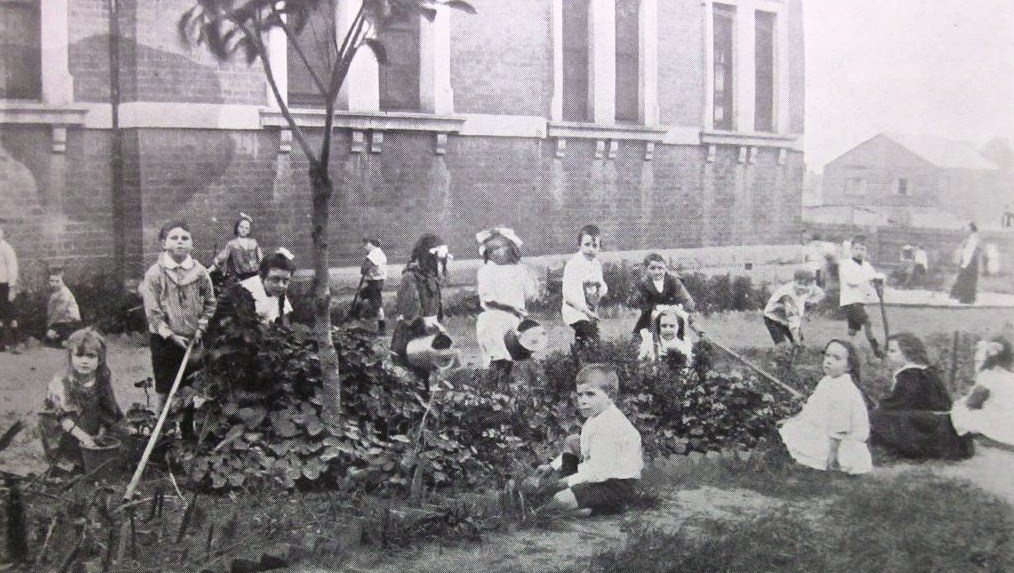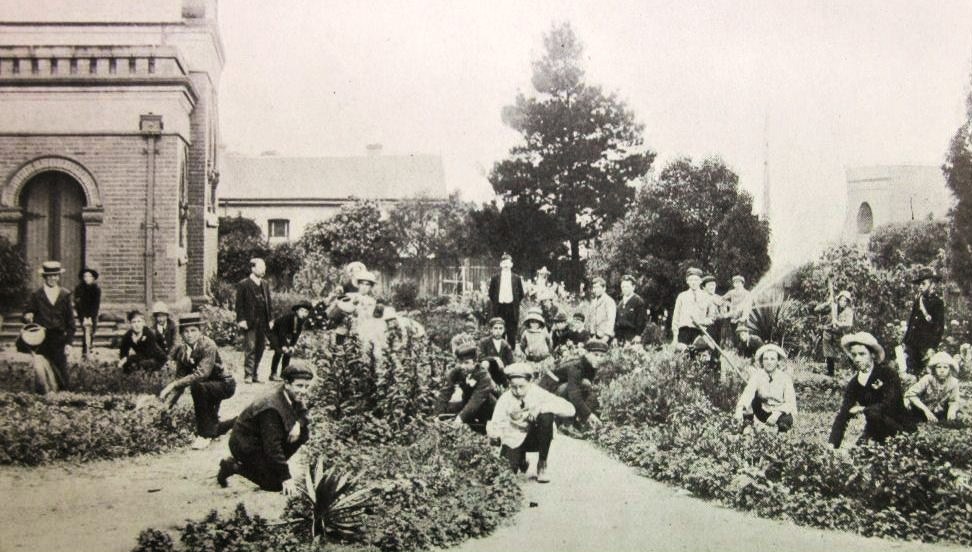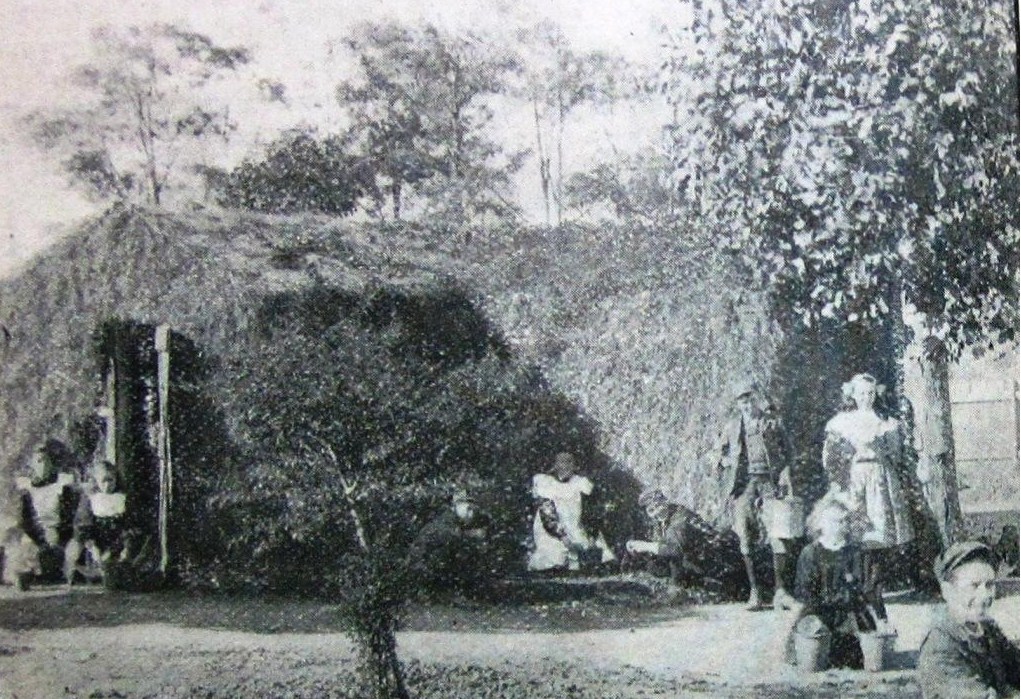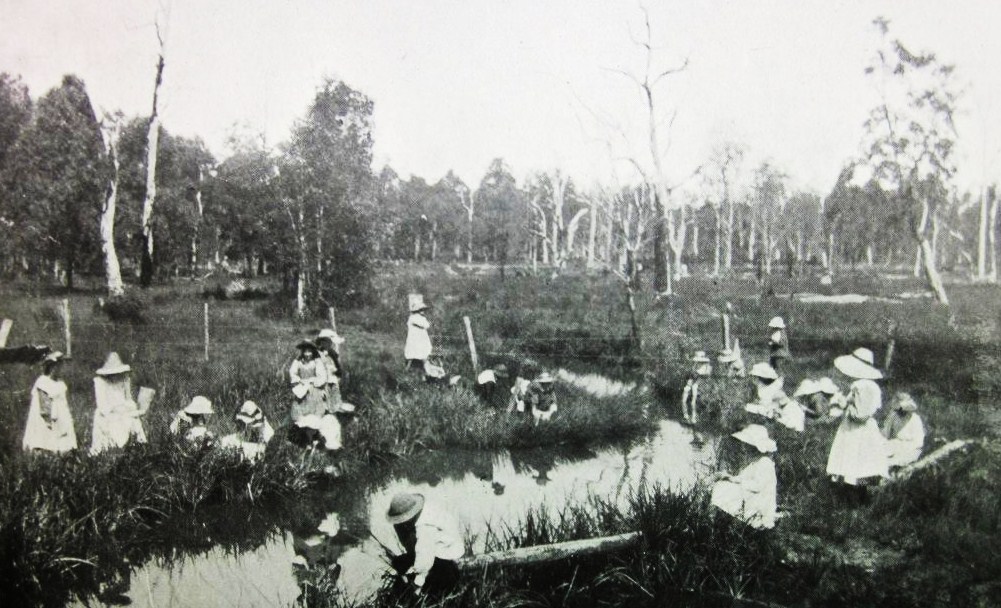Nature Study was a new subject introduced to elementary school curricula throughout the English speaking world in the 1890s and the early 1900s. It was an important component of the educational reform movement known as New Education. Nature Study was supported by a considerable body of theoretical and practical literature. Its subject matter introduced plant, animal, and geological studies to even the youngest children in elementary or primary schools. Direct observation from nature, questioning and reasoning and active learning replaced older methods of passive rote learning.
In each Australian state Nature Study was introduced to new syllabuses of instruction in the early years of the twentieth century, attracting the interest of educators, administrators, politicians, scientists and the public. Nature Study, with its particular methodology, was a flagship subject of New Education. While educators also sought reform in the teaching of established subjects, Nature Study was conceived and refined as incorporating new teaching methodologies, new theories of child psychology and learning, and new purposes for education.
Educational thought in the late nineteenth century saw developmental and child psychology emerge as new fields of research. In the same period, education was being expanded to include all children, and the basic education at first deemed adequate for working class children was broadened in terms of subject matter, and lengthened in terms of years spent at school. The increasing significance of science and technology in the modern world led to forceful arguments for the inclusion of science teaching at all levels of education.
The ‘Nature Study idea’
The ‘Nature Study idea’, as it was often referred to, developed its distinctive form in the United States in the 1890s and early 1900s. Prominent educators who had travelled to Europe and studied in Germany were putting into practice new educational ideas including the incorporation of natural science. Wilbur Jackman was one such educator who developed a distinctive course in natural science published as Nature Study for the Common Schools in 1891. ‘Nature Study’ was a term that had a brief history before 1891, but it was this influential book which gave it currency.
Jackman’s book established many of the basic tenets of Nature Study:
- lessons arranged by the seasons
- direct observation of nature by the child
- the importance of relating Nature Study to other subjects, and
- the child’s expression of his or her observations through speaking, writing and art.
Field Work in Nature Study, a later book by Jackman, stressed outdoor study and the need for plants and animals to be studied in relation to each other and their environment. Jackman’s writing witnessed the early association of the concepts of adaptation and ecology (itself in early stages of development as a field of study) with the teaching of Nature Study.
As Nature Study courses became popular in the United States and practical handbooks proliferated, several texts provided thoughtful analyses of Nature Study. Two of these were Nature Study and the Child by Charles B. Scott (1901) and The Nature-Study Idea: Being an Interpretation of the New School-Movement to put the Child in Sympathy with Nature by Liberty Hyde Bailey (1903). Both of these texts were influential in the Australian states.
Scott outlined several aims for Nature Study. First was the traditional aim of acquiring knowledge. Knowledge would be acquired from personal observation with the child asking not only ‘what’ but ‘why’. More importantly, Nature Study would create interest and ‘sympathy’ for nature. The child would proceed from interest to care and understanding, and to an emotional attachment to the natural world. Such an understanding and attachment was defined by Scott and others as ‘sympathy’. Closely related to sympathy was the aim to develop aesthetic values, an appreciation of the beauty of nature.
Scott (1901) additionally outlined his concerns for the physical environment:
We have adapted ourselves to our physical environment by stripping our land of its forests, our air of its birds, our waters of their fish, by using up in the most reckless manner our natural resources. Nature has been our slave, from whom we could take anything, to whom we owed nothing. (p. 123)
Nature Study, for Scott, would provide a new adaptation to environment, where children would wish to care for and protect natural resources.
For Bailey, lecturer at the Agricultural College of Cornell University, Nature Study was a new ideology, a new school movement, which aimed to place the child in a position of ‘sympathy’ with nature. For Bailey, as for Scott, Nature Study was more than science, drawing upon the child’s imagination, feeling and sympathy. Environmental aims for Nature Study pervaded Bailey’s text. As study led children to sympathy with nature, so they would ‘learn to love all nature’s forms and cease to abuse them’. (Bailey, 1903, p. 36)
Bailey promoted the study of a ‘central theme in a scene of life’ such as a brook. The brook would illustrate in miniature the forces which had shaped the earth’s surface and allow the study of its plant and animal life. Bailey was promoting the study of an ecosystem, a word not yet available to him, and the adaptations and interrelationships of its components.
Exponents of Nature Study outlined many aims for the subject: educational, economic, social, moral, and environmental. Difference of opinion on the subject’s purpose was inevitable. But all exponents stressed the importance of natural science as a topic to be introduced to elementary schools and to be taught through careful observation and problem solving. All believed that aesthetic appreciation and emotional responses to nature were appropriate for children. These aspects distinguished Nature Study from elementary science.
By the early 1900s Nature Study was defined by three basic components: scientific observation and reasoning; aesthetic appreciation; and the development of a close understanding of the natural world often referred to as ‘sympathy’. The subject was introduced into schools throughout the English speaking world, with prominent British educator, Patrick Geddes, endorsing Nature Study as a movement that was ‘wide and general, one affecting the education of both sexes, of all ages, and all countries’. (Official Report of the Nature-Study Exhibition and Conferences, 1903, p. 113)
Nature Study in Australia
Significant educational change proceeded in the early years of the new century in Australia. Frank Tate, educational reformer and newly appointed Director of Education in Victoria, enthusiastically promoted the educational advantages of Nature Study:
Nature study answers satisfactorily to every test the educator may apply … no subject can give more interesting and effective exercise in close and sustained observation, in comparison and generalization, in collecting and systematising truths, and in working out the causes and results of observed facts. (Tate, “Introduction” to Gillies and Hall, 1903)
Tate believed that Nature Study also satisfied the emotional and aesthetic necessities essential for the child, and would bring a much needed reality to education.
In New South Wales Peter Board placed Nature Knowledge in third position after English and Mathematics in a new Syllabus of Instruction for primary schools introduced in 1904. The teacher was instructed that Nature Knowledge entailed:
Making use of the child’s activity by getting him to do and to make things, the use of means to help him form vivid mental images, and the encouragement of his interest in his surroundings. The child is in this course to be no mere passive recipient of information; he will acquire knowledge actively. (“The New Syllabus of Instruction 1904” in New South Wales Educational Gazette, March 1904, p. 235)
In 1905 Board was appointed Undersecretary in the Department of Public Instruction and Director of Education. Both he and Tate remained enthusiastic advocates of Nature Study as an essential part of the reformed primary school syllabuses of their respective states.
In Victoria Nature Study was part of the “Proposed Course of Free Instruction” introduced in 1902 and the revised “Course of Study and Method of Inspection and Examination” in 1905.
Educational journals provided guidance to its teaching and the variety of plant, animal and natural phenomena which teachers could introduce. Nature Studies in Australia (1903), by author and teacher William Gillies and ornithologist Robert Hall, provided a school reader featuring Australian fauna and flora while The Aim and Method in Nature Study (1905), by reforming educator Charles Long, was an authoritative guide for Australian teachers. Nature Study was introduced to student teachers at the Training College by enthusiastic educator and naturalist John Leach. As Lecturer in Nature-Study at the Training College and Teacher of Geography and Nature-Study at the Melbourne Continuation School, Leach arranged programmes of field work excursions for the trainee teachers and school students. Often the excursions were accompanied by notable scientists and naturalists. Leach published Australian Nature Studies: A Book of Reference for those interested in Nature-Study in 1922, a book frequently reprinted and in use in Nature Study courses in Australia for decades.
The other Australian states also introduced Nature Study in the early years of the century. Indeed, in Western Australia, English educator Cyril Jackson had introduced Nature Study to the curriculum before the turn of the century as a subject particularly relevant for agricultural development. In South Australia, reform proceeded in 1906 under Director of Education, Alfred Williams. With his support, Nature Study was introduced to a new curriculum and Alfred Edquist appointed to the position of Supervisor of Nature Study. Edquist published Nature Studies in Australasia in 1916, providing a valuable text for Australian teachers. Tasmania and Queensland also introduced the subject to revised syllabuses, although both these states experienced significant problems in the early years of reform.
Nature Study in practice in New South Wales
After the introduction of the new syllabus in 1904 and the revised Course of Instruction for Primary Schools in 1905, Nature Study was to be taught to all classes of the primary school. The topic was addressed at meetings arranged by inspectors throughout the state. Papers given at those meetings were published in educational journals along with articles suggesting topical treatment ranging through plants, insects, birds, small animals, soils, geological specimens, geological features, and meteorology. Teachers were assured that they did not need special training or expensive apparatus, but did need enthusiasm and the desire to learn with the children.
Nature Study was defined and presented as it had developed in the United States: as distinct from elementary science or agriculture. In Australia there was an additional identification of Nature Study with Australia’s unique fauna and flora. Through Nature Study, children would not only gain knowledge about indigenous fauna and flora, but learn to love and care for it, and to identify it, and themselves, as distinctively and proudly Australian.
Surviving teachers’ Lesson Registers, inspectors’ Observation Reports of individual schools, and reports by teachers in the educational journals allow some insight into what was being experienced as Nature Study in classrooms in the years between 1905 and 1920. At Hunters Hill Public School in 1906 and 1907, the First class participated in weekly observation talks on leaves, the sun, a pear, seeds, and other topics. They would model natural items in a sand tray or draw them. They kept silkworms and grew seeds, cared for them and watched them changing. Leaves were observed in the playground. Stories about nature featured in English lessons.
Second class at Erskineville Superior Public School followed a similar programme in 1912. In addition the children dug, planted, cared for, and observed plants in the school garden. Their modelling made use of plasticine, a popular teaching aid of the period. Birds and their nests featured and Bird Day 1912 was celebrated by a week of work regarding bird life.
At Tuggerah Entrance, a small one teacher school, in 1917 and 1918 the children discussed what they observed on the way to school each day and brought various specimens into the classroom. After the ‘chat’ on a cocoon, a nest, a snail, a wildflower, or on one occasion a snake, the children would write about their observations, and draw the specimen. They observed which birds visited the playground, and grew plants in boxes.

Figure 1: Nature study in the garden, Camdenville Public School, Sydney. Report of the Minister of Public Instruction for the Year 1909, p.91.

Figure 2: Gardens at Drummoyne Public School, Sydney. Report of the Minister of Public Instruction for the Year 1910, p.88.

Figure 3: Bush house at Goughtown Public School, Merrylands, near Sydney. Halsted, J. 1910. Notes on Gardening and Elementary Agriculture, Sydney, Websdale, Shoosmith, p. 208.
School gardens supported Nature Study and many photographs from this period feature children at work in their gardens. (Figures 1-2). At Camdenville in Sydney small children tend flowers and vegetables while a larger scheme is in evidence at Drummoyne Public School. Where land was limited or conditions harsh, some schools constructed bush houses of wire netting, saplings, reeds and lattice (Figure 3).
Aquariums and terrariums were promoted through articles in the educational journals. At Blayney Public School the children constructed a large aviary, where they observed the habits of several kinds of birds. This school also had an outdoor aquarium at the main entrance, with a fountain, water plants and fish. Nature Study incorporated preliminary research into, as well as observation of the animal and plant life within aviary and aquarium.

Figure 4: Nature study of the swamp, Mororo Public School, Clarence Valley, Northern NSW. Report of the Minister of Public Instruction for the Year 1911, p.102
Excursions beyond the school playground were encouraged. For country schools these might consist of a bush ramble. For those close to Sydney teachers arranged trips to the Zoo, the Botanical Gardens, the Observatory and the Museum. Boys from Kogarah Public School travelled by train to Otford for a ‘tramp’ to Stanwell Park in 1906. The boys examined plants and flowers, caught butterflies and grasshoppers to take back to school and observed the view of the coast before descending the escarpment and noting the changes in vegetation. At Dulwich Hill Public School in Sydney the teacher took students of the upper classes to the Cooks River once a month to observe and collect botanical specimens. At Mororo, in the Clarence River Valley, the children appear absorbed in the study of the plant and animal life of a swamp (Figure 4).
The purpose of Nature Study
As in the United States, advocates of Nature Study in Australia stressed varying aims. Nature Study as a foundation for science and/or agriculture was certainly important. Advocates also made strong pleas for fostering interest in and emotional attachment to indigenous fauna and flora. Some took this a logical step further linking Nature Study in schools with the need for conservation and preservation of fauna, flora and landscape.
Two influential advocates in New South Wales were Charles Musson, lecturer at Hawkesbury Agricultural College, and Alexander Hamilton, school teacher and lecturer in Nature Study at Sydney Teachers College. Both embraced Nature Study in its entirety and both promoted its conservation ethic. Nature Study would educate the young to be more aware of their natural environment and the need for its protection.
In 1910 the Gould League of Bird Lovers of New South Wales was organised by teachers, and operated within the Department of Public Instruction, supported, like Nature Study, by prominent educators, naturalists, and scientists. The League immediately became popular, with branches in schools throughout the State. It promoted protection for birds because they had an intrinsic value, important for aesthetic appreciation, as inspiration for literature and as inspiration for national identification. Much was written about the ‘usefulness’ of birds, but utilitarian motivations for their preservation were accompanied by appeals to sympathy and regard for their beauty. The League thus meshed very well with the philosophy of Nature Study. Nature Study witnessed great attention to bird study after the formation of the League.
Nature Study’s legacy
Nature Study would remain part of primary school syllabuses in each state for decades.
In New South Wales Nature Study remained a specifically designated subject in syllabuses of instruction until 1952 when it became ‘Natural Science’. Within schools, however, teachers continued to use the term ‘Nature Study’ into the 1960s. In 1980 the natural science syllabus was replaced by Investigating: Science (K-6) and this document in turn was superseded by Science and Technology K-6 in 1991.
Although no longer taught in schools, Nature Study did leave a legacy in terms of subject matter, methodology and its distinctive definition which incorporated aesthetic appreciation and ‘sympathy’ or ‘empathy’ with nature. Its subject matter and methodology continued within the two Key Learning Areas (KLAs) Science and Technology K-6 and Human Society & Its Environment K-6. Documents introducing environmental education across the KLAs incorporated many of the concerns of Nature Study with attention to attitudes and feelings, aesthetic appreciation and responsibility for the environment.
Nature Study must also be considered as having an influence on the environmental movement which made such an impact in the late twentieth century. Nature Study was not only a forerunner to later environmental movements, but contained the potential to influence ideas and perceptions about the natural environment, particularly as it was presented to children in schools.
NOTE
The official Education Department gazettes of each colony and state are important primary sources for tracing the history of Nature Study.
